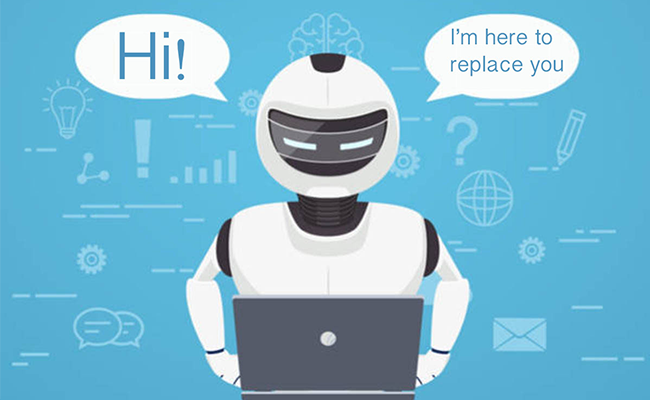Hallucinations of a post robot-apocalypse plague us all, right? But rather than white-knuckling our bed sheets every night worrying about a vague future with self-driving cars that decide to simultaneously drive half of us into the ocean, our energy would be better spent focusing on the aspects of life that artificial intelligence has already sneakily taken over. There are more than you think.
From chatbots that fake human interaction so seamlessly that users never even know they’re talking to a computer, to predictive advertisement that knows you’re going gluten-free before you do, to software that can scan your face and determine your sexual orientation with horrific accuracy, reliable AI has graduated from embarrassing you at chess to knowing more about your life than your high school therapist.
A word of advice: think again before you start flirting with that chat assistant with the cute thumbnail because chances are it lacks a warm body.
Ever since Alan Turing published “Computing Machinery and Intelligence” in 1950, AI has been a mainstream talking point. And as early as 1966, devices were able to trump (however rudimentarily) what became known as “the Turing test,” where they are tasked to display behavior intelligent enough to pass as equivalent to, or indistinguishable from, that of a human. Progress since then has exploded—to the point where chatbots have already replaced many human jobs.
For most of us, our first personal acquaintance with AI came with SmarterChild’s release in 2001. Remember SmarterChild? I know, right?! At the height of its popularity, this baby bot could be found in more than 10 million AIM buddy lists and was receiving over a billion messages per day. Although SmarterChild’s ability to almost instantly access and spit back data from a variety of resources (e.g. weather reports, sport stats, stock prices and movie times) did make it a potentially useful personal assistant, its main appeal was its sassy chat function.


But chatbot technology has advanced from keeping pimply teenagers on AIM company to being a vital facet of countless online industries. As reported by WWD, a survey by PointSource revealed that websites who implement chatbots well will see one-third of their shoppers spend more money than websites who eschew integrating digital sales assistants. From emailing with your insurance underwriter to buying car batteries online, instances of seamless bot integration abound. What’s more is that companies aren’t required (yet?) to alert you to whether or not the “person” you’re chatting with actually owns a liver.
Of course not all chatbots are created equal. Many need not be reminded of Microsoft’s failed “Tay” experiment, which was designed to mimic the speech patterns of a 19-year-old American girl. In hopes of having her learn as much about the subtleties and nuances of language and interaction as quickly as possible, her creators let loose the reigns and Tay took to Twitter.
At the time, Microsoft touted its creation as the most advanced bot of its kind, but it was quickly discovered that Tay lacked something the way of social grace. The derogatory (and sometimes outright racist) trash Tay was talking got the experiment axed a mere 16 hours after going live. Score one for humankind!
Unfortunately for us warmbodies, though, chatbot technology has many AI sisters, one of which is called predictive advertising. Also called pretargeting, it has its roots in retargeting, which can be reductively defined as ads that show a user the thing he or she has already either searched for or purchased. While retargeting is still the dominant force in the online advertisement game, predictive marketing has already made an indelible mark on the scene.
Facebook’s Lookalike advertising program is one of the most prevalent today. By caching all your pixels (i.e. cookies that hold information like where you’ve been and what you’ve seen) and combining that with other known demographic information (think: gender, age, income, place of origin, etc.), Facebook automatically creates a profile for you. And that’s not even the scary part.
After your profile is created, you are algorithmically lumped together with users who have similar pixel and demographic information, or “lookalikes”. Since these strangers are basically your social and economic alter egos, it stands to reason that whatever they are searching for and buying will also interest you. And the next thing you know – BOOM! – the Kenny G album that’s been your secret desire is on a banner next to your news feed.
Whereas worrying about our species’ destruction at the metallic hands of robot pirates is the long game, privacy is at the heart of our present concerns. And while predictive advertising might seem invasive, by no means is it the furthest extent of AI’s creepy reach – not by a long shot.
Although Phrenology has been debunked as pseudoscience for nearly two centuries, a similar and unimaginably more accurate technology has recently emerged that uses facial characteristics to determine a touchy social line in the sand: gay from straight. A Stanford University study confirmed that its deep-learning algorithm can now determine an individual’s sexual orientation with up to 91% accuracy based on photos alone.
Obvious ethical questions swarm around this issue, the most common of which being along the lines of “why did they spend their time creating a potentially discriminatory algorithm instead of one that can provide more socially useful conclusions, like if someone has cancer?” The answer is nearly as shocking as the reason for asking it.
It turns out that “machine gaydar” (their term, I sh** you not) relies on two basic types of visual information: permanent, like bone structure; and transient, like eyebrow shape. So basically, rather than only using its victims’ fixed biological traits as determiners, it also decides whether a person simply “looks” gay. Since AI works best with data that centers on people’s choices, and considering that things like eyebrow shape can be chosen while features like Jay Leno’s chin cannot, it makes a little more sense why the gay: straight differentiation was their field of study. I guess.
So AI is already all over our lives and there’s no stopping its progress. Small wonder why it, not aliens, is now man’s most feared apocalypse. Notwithstanding the fact that it’s added measurable convenience to certain aspects of our lives, people are still leery of relinquishing too much control to automated systems. And for good reason, it seems.
But as long as people like me spend sleepless nights worrying about these things, rest assured that there will be a vanguard between you and the first time your smartphone demands you wash your grimy human hands before touching its pristine surface. I give it at least a couple months.
In the meantime…


